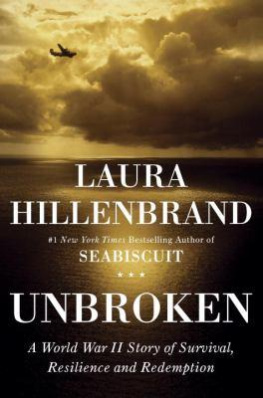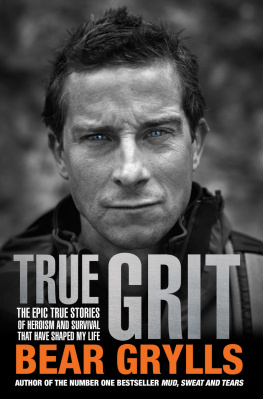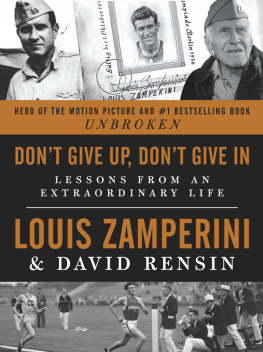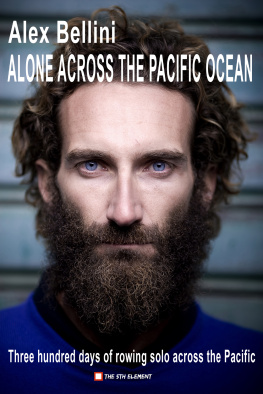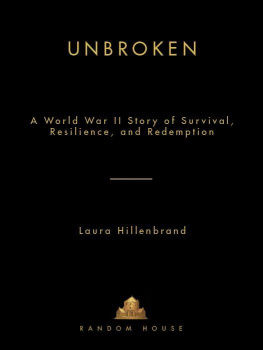Also by Laura Hillenbrand
SEABISCUIT
Copyright 2010 by Laura Hillenbrand
All rights reserved.
Published in the United States by Random House, an imprint of The Random House Publishing Group, a division of Random House, Inc., New York.
R ANDOM H OUSE and colophon are registered trademarks of Random House, Inc.
LIBRARY OF CONGRESS CATALOGING-IN-PUBLICATION DATA
Hillenbrand, Laura.
Unbroken : a World War II story of survival, resilience, and redemption / Laura Hillenbrand.
p. cm.
eISBN: 978-0-679-60375-7
1. Zamperini, Louis, 1917 2. World War, 19391945Prisoners and prisons, Japanese. 3. Prisoners of warUnited StatesBiography. 4. Prisoners of warJapanBiography. 5. World War, 19391945Aerial operations, American. 6. World War, 19391945CampaignsPacific Area. 7. United States. Army Air Forces. Heavy Bombardment Group, 307th. 8. Long-distance runnersUnited StatesBiography. I. Title.
D805.J3Z364 2010
940.547252092dc22
[B] 2010017517
www.atrandom.com
v3.1
For the wounded and the lost
What stays with you latest and deepest? of curious panics,
Of hard-fought engagements or sieges tremendous what deepest remains? Walt Whitman, The Wound-Dresser
CONTENTS


PREFACE
A LL HE COULD SEE, IN EVERY DIRECTION, WAS WATER . It was June 23, 1943. Somewhere on the endless expanse of the Pacific Ocean, Army Air Forces bombardier and Olympic runner Louie Zamperini lay across a small raft, drifting westward. Slumped alongside him was a sergeant, one of his planes gunners. On a separate raft, tethered to the first, lay another crewman, a gash zigzagging across his forehead. Their bodies, burned by the sun and stained yellow from the raft dye, had winnowed down to skeletons. Sharks glided in lazy loops around them, dragging their backs along the rafts, waiting.
The men had been adrift for twenty-seven days. Borne by an equatorial current, they had floated at least one thousand miles, deep into Japanese-controlled waters. The rafts were beginning to deteriorate into jelly, and gave off a sour, burning odor. The mens bodies were pocked with salt sores, and their lips were so swollen that they pressed into their nostrils and chins. They spent their days with their eyes fixed on the sky, singing White Christmas, muttering about food. No one was even looking for them anymore. They were alone on sixty-four million square miles of ocean.
A month earlier, twenty-six-year-old Zamperini had been one of the greatest runners in the world, expected by many to be the first to break four-minute mile, one of the most celebrated barriers in sport. Now his Olympians body had wasted to less than one hundred pounds and his famous legs could no longer lift him. Almost everyone outside of his family had given him up for dead.
On that morning of the twenty-seventh day, the men heard a distant, deep strumming. Every airman knew that sound: pistons. Their eyes caught a glint in the skya plane, high overhead. Zamperini fired two flares and shook powdered dye into the water, enveloping the rafts in a circle of vivid orange. The plane kept going, slowly disappearing. The men sagged. Then the sound returned, and the plane came back into view. The crew had seen them.
With arms shrunken to little more than bone and yellowed skin, the castaways waved and shouted, their voices thin from thirst. The plane dropped low and swept alongside the rafts. Zamperini saw the profiles of the crewmen, dark against bright blueness.
There was a terrific roaring sound. The water, and the rafts themselves, seemed to boil. It was machine gun fire. This was not an American rescue plane. It was a Japanese bomber.
The men pitched themselves into the water and hung together under the rafts, cringing as bullets punched through the rubber and sliced effervescent lines in the water around their faces. The firing blazed on, then sputtered out as the bomber overshot them. The men dragged themselves back onto the one raft that was still mostly inflated. The bomber banked sideways, circling toward them again. As it leveled off, Zamperini could see the muzzles of the machine guns, aimed directly at them.
Zamperini looked toward his crewmates. They were too weak to go back in the water. As they lay down on the floor of the raft, hands over their heads, Zamperini splashed overboard alone.
Somewhere beneath him, the sharks were done waiting. They bent their bodies in the water and swam toward the man under the raft.

Courtesy of Louis Zamperini. Photo of original image by John Brodkin.
One
The One-Boy Insurgency
I N THE PREDAWN DARKNESS OF AUGUST 26, 1929, IN THE back bedroom of a small house in Torrance, California, a twelve-year-old boy sat up in bed, listening. There was a sound coming from outside, growing ever louder. It was a huge, heavy rush, suggesting immensity, a great parting of air. It was coming from directly above the house. The boy swung his legs off his bed, raced down the stairs, slapped open the back door, and loped onto the grass. The yard was otherworldly, smothered in unnatural darkness, shivering with sound. The boy stood on the lawn beside his older brother, head thrown back, spellbound.
The sky had disappeared. An object that he could see only in silhouette, reaching across a massive arc of space, was suspended low in the air over the house. It was longer than two and a half football fields and as tall as a city. It was putting out the stars.
What he saw was the German dirigible Graf Zeppelin. At nearly 800 feet long and 110 feet high, it was the largest flying machine ever crafted. More luxurious than the finest airplane, gliding effortlessly over huge distances, built on a scale that left spectators gasping, it was, in the summer of 29, the wonder of the world.
The airship was three days from completing a sensational feat of aeronautics, circumnavigation of the globe. The journey had begun on August 7, when the Zeppelin had slipped its tethers in Lakehurst, New Jersey, lifted up with a long, slow sigh, and headed for Manhattan. On Fifth Avenue that summer, demolition was soon to begin on the Waldorf-Astoria Hotel, clearing the way for a skyscraper of unprecedented proportions, the Empire State Building. At Yankee Stadium, in the Bronx, players were debuting numbered uniforms: Lou Gehrig wore No. 4; Babe Ruth, about to hit his five hundredth home run, wore No. 3. On Wall Street, stock prices were racing toward an all-time high.
After a slow glide around the Statue of Liberty, the Zeppelin banked north, then turned out over the Atlantic. In time, land came below again: France, Switzerland, Germany. The ship passed over Nuremberg, where fringe politician Adolf Hitler, whose Nazi Party had been trounced in the 1928 elections, had just delivered a speech touting selective infanticide. Then it flew east of Frankfurt, where a Jewish woman named Edith Frank was caring for her newborn, a girl named Anne. Sailing northeast, the

